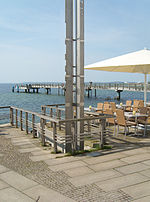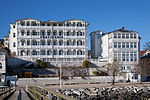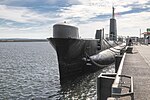Herthasee (Rügen)
Geography of RügenLakes of Mecklenburg-Western Pomerania

Herthasee is a lake on the island Rügen, Mecklenburg-Vorpommern, Germany. At a length of 170 m and a width of 140 m, it covers a surface area of 0.202 km2. It has a maximum depth of 11 m. It is located in the center of the Jasmund National Park and its famous chalk cliffs. At its embankment, the lake features a Slavic hill fort called Herthaburg, with a height of 17 m. It was constructed and inhabited between the 8th and 12th century.
Excerpt from the Wikipedia article Herthasee (Rügen) (License: CC BY-SA 3.0, Authors, Images).Herthasee (Rügen)
Stubbenkammer,
Geographical coordinates (GPS) Address Nearby Places Show on map
Geographical coordinates (GPS)
| Latitude | Longitude |
|---|---|
| N 54.568611111111 ° | E 13.647777777778 ° |
Address
Stubbenkammer
18546
Mecklenburg-Vorpommern, Germany
Open on Google Maps










